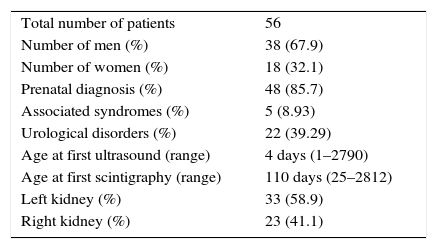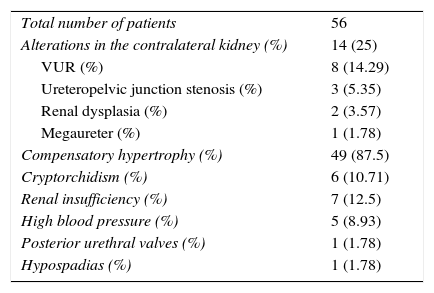To assess the need for implementing renal scintigraphy in the diagnosis of the multicystic dysplastic kidney (MCDK) and the safety of its conservative treatment.
Material and methodsA retrospective study of patients with unilateral MCDK was conducted at our center from January 2005 to August 2015. We calculated the positive predictive value (PPV) of ultrasonography, taking renal scintigraphy and pathology as the gold standard. We calculated a survival curve according to the Kaplan–Meier method to assess the annual probability of spontaneous resolution of the multicystic kidney.
ResultsFifty-six patients were identified, 48 (85.7%) of whom had a prenatal diagnosis. Thirty eight (67.9%) of the patients were males, and the left side was affected in 33 (58.9%) of the patients. We observed associated urological abnormalities in 22 (39.29%) patients, with vesicoureteral reflux the most common (8, 14.29%). Seven patients (12.5%) developed renal failure. Forty-nine (87.5%) patients developed compensatory contralateral renal hypertrophy. Of the 33 patients who underwent surgery, the pathology results confirmed the MCDK diagnosis in 32. Compared with scintigraphy and pathology, the PPV of ultrasonography was 100% and 97%, respectively.
The rate of spontaneous involution was 5.4% at 3 months of life, 11.3% at 2 years and 38.4% at 5 years.
ConclusionsIn our experience, the conservative treatment of MCDK, until at least 5 years of age, is safe. Our data suggest that performing scintigraphy is not required for these patients, which means lower radiation exposure, as well as financial savings.
Evaluar la necesidad de la realización de la gammagrafía renal en el diagnóstico de la displasia renal multiquística (DRMQ), así como la seguridad de su tratamiento conservador.
Material y métodosEstudio retrospectivo de los pacientes con DRMQ unilateral en nuestro centro desde enero de 2005 hasta agosto de 2015. Calculamos el valor predictivo positivo (VPP) de la ecografía tomando la gammagrafía renal y la anatomía patológica como gold standard. Realizamos una curva de supervivencia según el método de Kaplan-Meyer para evaluar la probabilidad de resolución espontánea del RM anualmente.
ResultadosSe han identificado 56 pacientes, 48 (85,7%) con diagnóstico prenatal, 38 (67,9%) fueron varones y en 33 (58,9%) el lado afecto fue el izquierdo. En 22 (39,29%) observamos anomalías urológicas asociadas, el reflujo vesicoureteral la más frecuente (8 [14,29%]). Siete pacientes (12,5%) han desarrollado insuficiencia renal, y 49 pacientes (87,5%) desarrollaron hipertrofia renal contralateral compensatoria. De los 33 pacientes que se intervinieron el resultado de anatomía patológica confirmó el diagnóstico de DRMQ en 32. En comparación con la gammagrafía el VPP de la ecografía fue del 100% y del 97% al compararla con la anatomía patológica.
La tasa de involución espontánea fue del 5,4% a los 3 meses de vida, del 11,3% a los 2años y del 38,4% a los 5 años.
ConclusionesEn nuestra experiencia el tratamiento conservador de la DRMQ, hasta al menos los 5 años de edad, es seguro.
Nuestros datos sugieren que la realización de la gammagrafía no es precisa en estos pacientes, lo que supone una menor exposición a la radiación, así como un ahorro económico.









